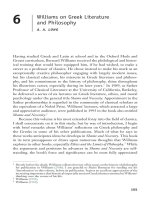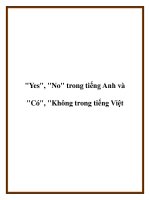ralph vaughan williams symphony no 5
Bạn đang xem bản rút gọn của tài liệu. Xem và tải ngay bản đầy đủ của tài liệu tại đây (32.11 KB, 3 trang )
Ralph Vaughan Williams - Symphony Number FiveRalph Vaughan
Williams, descended from the famous Wedgwood and Darwin families,
was born at Down Ampney, Gloucestershire in 1872. In 1890 he entered
the Royal College of Music, and in 1892 he entered Trinity College,
Cambridge. One of the greatest of the British composers, a prolific writer
of music, folksong collector, and champion of British cultural heritage, he
died aged 85 in 1958. His ashes are interred in Westminster Abbey
alongside the nation's greatest artists and poets. Symphony No. 5 in
DIntroductionThe symphony contains a lot of material from RVW's then
unfinished opera, The Pilgrim's Progress. When he began the Fifth
Symphony, RVW thought he may never finish the opera, and didn't want
to waste any good ideas. The symphony does not have a programme, it
is absolute music. It is in four movements: a "Preludio" first movement, a
Scherzo, a "Romanza" slow movement, and a "Passacaglia" finale.First
Movement : PreludioFrom the very beginning, RVW puts the key
signature of this movement into doubt. The movement opens with a horn
call in D, set against a firm base (or bass?) of octave C's. Could it be that
in the great traditions of British musical 'amateurism', RVW got his
transposition wrong? Or is this a deliberate feature of the music, intended
to blur the tonality? Musicologists prefer the latter explanation. This is by
no means an unusual feature of his music, when he was asked what the
4th symphony was about, RVW replied "It is about F-minor", alluding to
his sometimes hazy tonalities, often augmented by his use of modal,
mainly pentatonic melodies, which, with no leading note, often help to
'fudge' the tonality. Apart from the horn call, the brass is seldom used,
and the texture is light and airy. The first violins then enter, high on the E
string, doubled at the octave below by the seconds in an introduction,
before their main theme at (1), doubled by flutes. The triplets add
rhythmic variety, as well as providing a distinctly 'folkie' feel. During the
course of the movement, the distinctive dotted rhythm of the horns hardly
ever leaves us. There are some rather abrupt key changes. i.e. Eb to E at
(5). We are taken into the Allegro by a sudden change in mood. The
music darkens with a slightly sinister version of the horn call in the
bassoons. We then enter the Allegro, with a scurrying in the strings,
whilst the wind begins a downward progression of notes, which builds to a
climax, with strings in semiquavers, until we reach the original tempo
once more, as the music winds down, back to the horn call. Some
development of ideas takes place, before the music once again winds
down. The horn calls are answered by single notes in woodwind, and the
movement ends as mysteriously as it began - the horns fade into the
distance, in the key of D, but we are left, somewhat perturbed by the
pianissimo cello C against the viola D. The movement is plainly 20th
century, with many dissonances, yet the movement, for the most part,
sounds serene, with a sinister undertone that barely breaks the surface.
Much of this softening comes from RVW's orchestration: he tends to work
in distinct "chunks" of sound. In the opening measures, for example, the
low cellos and basses are separated from the higher horns in range and
sound colour.Second Movement : ScherzoThe movement starts with
rising string fourths, which seem to come from nowhere. This time, it is
the time signature of the movement that we must look out for. The piece
starts in dotted minims, but then the note values become minims, before
the seventh bar, in which a rather jaunty tune begins, and continues
through a rather melancholy unison entry by flute and bassoon., which is
continued in woodwind, until we reach a short staccato section, just
before (2), where there is a rather absurd quaver dialogue between
woodwind and strings. More staccato work from strings leads to a rather
fat sounding appoggiated dotted minim passage for oboe and cor anglais.
Here we get passages of two against three, in the tune. After the double
bar after (14), we get that nimble staccato passage back, this time
pianissimo, it all has a rather tongue - in - cheek feel to it, accentuated by
the slightly heavy bass. The strings endure another scurrying passage,
then after (17), a new, almost fatalistic downwards theme is introduced,
which gradually gains in intensity, until it is eventually played tutti. The
first theme, with its rising fourths re - enters pp, and this movement ends
suddenly, with a cheeky downwards run, from the 'top' of the strings, to
the 'bottom'. Strings play largely at the unison or octave throughout this
movement, and winds are usually reduced to solos or duets. When there
is a lot of woodwind, the strings drop out, fitting in with the contrasting
planes of sound discussed in the first movement.Third Movement :
RomanzaAn almost ethereal chord progression in (heavily) divisi strings
announces a melody, which begins with the almost obligatory triplet
rhythm in the cor anglais. Rising 4ths then lead to a broad tune in the
strings, which subsides into the flute, oboe, cor anglais, and clarinet
playing the rising 4ths once more. This leads to a repeat of the opening
section, but scored the opposite way round, with woodwind playing the
chords, and the melody , still pp, in the strings. It is scored very low fr the
violins - in fact, the first four Gs must be played open, with no vibrato to
soften them. Very agricultural. We then get a bigger statement of the
broad tune, followed by some birdsong - like passages from woodwind,
which develop thematically until we reach the Poco Meno Mosso at (7),
where rustling strings accompany the first theme on horns, then trumpets.
Brass chords lead us back to the main string tune, which leads on to the
'big tune', and the climax of this movement. A solo violin reminds us of
the woodwind's birdsong theme. The ethereal string chords reappear,
with a horn melody over the top, and muted strings finally send this
movement to sleep. Fourth Movement : PassacagliaThe passacaglia
theme begins, as usual, in the bass a descending line. A bit in, a rising
counter-melody sneaks in through the upper parts. This reaches a small
climax after 5 repetitions, at which point the bass fragments into pizzicato.
Three more repetitions follow, rising to a 'fanfare' section. This plays
against the passacaglia's counter-melody.At this point, RVW gives up the
passacaglia We get an imitative section on the passacaglia, which again
leads to the fanfare. The fanfare combines with the passacaglia and the
counter-melody, with shimmering strings.The fanfare reaches a climax
which quickly leads to an agitated version of the passacaglia on clarinet
and other woodwind, against tremelando strings (pp). The rumblings grow
to three 'outcries' of this version. We then hear a disturbed version of the
counter-melody, leading to a large climax on the original passacaglia
theme.This breaks into music from the first movement, the Preludio,
signifying that we have come full circle, and the end is near. Various
themes from the first movement float make special guest appearances,
which leads to a quiet extended fantasia on the counter-melody, fanfare,
and passacaglia. The movement ends with the violins playing extremely
high minims - a very serene ending.









